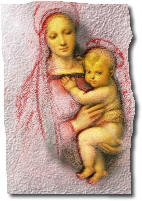
The Litttle Office Of Mary
INTRODUCTION

| HOME | SUMMA | PRAYERS | FATHERS | CLASSICS | CONTACT |
| CATHOLIC ENCYCLOPEDIA | A | B | C | D | E | F | G | H | I | J | K | L | M | N | O | P | Q | R | S | T | U | V | W | X | Y | Z |
| CATHOLIC SAINTS INDEX | A | B | C | D | E | F | G | H | I | J | K | L | M | N | O | P | Q | R | S | T | U | V | W | X | Y | Z |
| CATHOLIC DICTIONARY | A | B | C | D | E | F | G | H | I | J | K | L | M | N | O | P | Q | R | S | T | U | V | W | X | Y | Z |
 Keep Site Running
Keep Site Running

The Litttle Office Of Mary |
The Little Office of Our Lady also known as Hours of the Virgin is
a liturgical devotion to the Blessed Virgin Mary, in imitation of,
and usually in addition to, the Divine Office in the Roman Catholic
Church. It is a cycle of psalms, hymns, scripture and other readings. History The Little Office of the Blessed
Virgin Mary probably originated as a monastic devotion around the
middle of the eighth century. Peter the Deacon reports that at the
Benedictine Monastery of Monte Cassino there was, in addition to the
Divine Office, another office "which it is customary to perform
in honour of the Holy Mother of God, which Zachary the Pope commanded
under strict precept to the Cassinese Monastery."
The Little Office of the Blessed
Virgin Mary is a variation of the Common of the Blessed Virgin Mary
in the Liturgy of the Hours (Divine Office). It may have originally
been put together to be prayed in connection with the Votive Masses
of Our Lady on Saturday, which were written by Alcuin, the liturgical
master of Charlemagne’s court. Peter Damian states that it was
already commonly recited amongst the secular clergy of Italy and
France, and through his influence the practice of reciting it in
choir after the Monastic Office, was introduced into several Italian
houses. However, the Little Office did not come into general use
before the tenth century; and in the eleventh century there were at
least two versions the Little Office extant in England. Pre-English
Reformation versions varied considerably, and in England in medieval
times the main differences were between the Sarum and York uses.
Several early printed versions of the English uses of the Little
Office survive in the Primers. In the twelfth century, the new
foundation of the Augustinian Canons of Prémontré
prescribed the Little Office in addition to the eight hours of the
Divine Office. The Austin Canons also used it, and, perhaps through
their influence, it developed from a private devotion into part of
the daily duty of the secular clergy as well in the thirteenth and
fourteenth centuries. By the fourteenth century the Little Office was
obligatory for all the clergy. This obligation remained until St.
Pius V changed it in 1568. The Little Office varied in different
communities and locations, but was standardized by Pius V in 1585. It
became part of the Books of Hours in Mary’s honor and was used
by many lay people. Beautifully decorated Books of Hours were the
pride of many a noble. Women’s congregations and Third Orders
often made it mandatory for their members to pray the Little Office. Down to the Reformation it formed a
central part of the "Primer" and was customarily recited by
the devout laity, by whom the practice was continued for long
afterwards among the persecuted Catholics. An English-only version
appears appended to versions of Bishop Richard Challoner's 'Garden of
the Soul' in the eighteenth century, and with the restoration of the
hierarchy in the 1860s, James Burns issued a Latin and English
edition. Minor revisions of the Office occurred
in the twentieth century, most notably in 1910, as part of Pope Pius
X's liturgical reforms. The most significant change made by the
pontiff was the shortening of the numbers of psalms recited at Lauds
from seven to four (excluding the canticle). In the reforms following the Second Vatican Council, the Little
Office was overshadowed by the revised Liturgy of the Hours.
According to Apostolic Letter Ecclesiae sanctae of Pope Paul VI, Although Religious who recite a duly approved Little Office
perform the public prayer of the Church (cf. Constitution
Sacrosanctum Concilium, No. 98), it is nevertheless recommended to
the institutes that in place of the Little Office they adopt the
Divine Office either in part or in whole so that they may participate
more intimately in the liturgical life of the Church...." The Little Office was not officially revised after the Council, as
many Congregations abandoned it in order to adopt the Liturgy of the
Hours. However, that has not stopped several post-conciliar editions
being issued. The Carmelites produced a revised version of their form
of the office, which is still used by some Religious and those who
are enrolled in the Brown Scapular. Additionally Tony Horner, a
layman, and Father John Rotelle, O.S.A. both formulated their own
editions of the Little Office which conformed to the revised Liturgy
of the Hours, both of these are approved for private use. These newer
versions include vernacular translations from the Latin and follow
the new structure of each Hour in the Office.INTRODUCTION
From Wikipedia.org under the Creative Commons
Attribution-ShareAlike License
Copyright ©1999-2023 Wildfire Fellowship, Inc all rights reserved